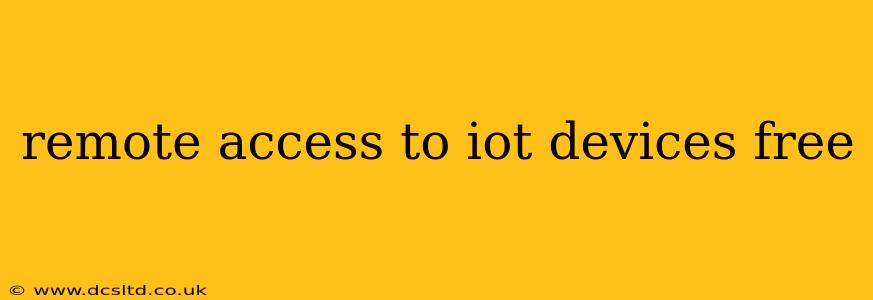The Internet of Things (IoT) is rapidly expanding, connecting everyday devices to the internet. This connectivity offers incredible convenience, but it also raises security concerns, especially regarding remote access. Many users seek free options for remote access to their IoT devices, but it's crucial to understand the limitations and potential risks involved. This article explores free methods for remote access, highlighting their advantages and disadvantages to help you make informed decisions.
What are the free options for remote access to IoT devices?
Several methods offer free remote access to IoT devices, albeit with varying levels of security and functionality. The most common include:
-
Using a device's built-in features: Many IoT devices offer rudimentary remote access through their manufacturer's app. This is often the simplest approach, but functionality is usually limited, and security can be questionable. Think of basic smart home devices—their apps usually provide a form of remote control, but rarely offer advanced features or robust security protocols.
-
Leveraging existing network infrastructure: If your IoT device is on your home network, and you have a VPN or remote desktop software already set up, you might be able to access it remotely through that infrastructure. This requires technical knowledge to configure properly and is only suitable for devices that support such connections.
-
Publicly available cloud platforms (with limitations): Some cloud platforms offer limited free tiers that allow for remote device management, but these usually have restrictions on data storage, bandwidth, or functionality. Often, these free tiers are only suitable for very simple projects or testing purposes.
-
Open-source solutions: There are open-source projects and software available that enable remote access. These options, however, typically require a good level of technical expertise to set up, configure and maintain securely. Improper configuration can significantly expose your devices to vulnerabilities.
Are there any risks associated with free remote access to IoT devices?
Yes, free remote access methods often compromise security. Here are key risks:
-
Increased vulnerability to hacking: Free services often lack robust security features, making your IoT devices more susceptible to unauthorized access and malicious attacks. Think of it as a poorly locked door – inviting trouble.
-
Data breaches: Unauthorized access can lead to data theft or manipulation, compromising sensitive information. The implications depend on the type of device and the data it collects.
-
Lack of support: Free solutions usually don't come with technical support. If something goes wrong, you'll likely have to troubleshoot the issue on your own.
How can I improve the security of my IoT devices when using free remote access?
Even with free options, you can take steps to mitigate risks:
-
Strong passwords: Use complex, unique passwords for each device and avoid default passwords.
-
Two-factor authentication (2FA): If available, enable 2FA to add an extra layer of security.
-
Regular software updates: Keep your IoT devices' firmware and apps updated to patch security vulnerabilities.
-
Firewall protection: Use a firewall to restrict access to your IoT devices.
What are the alternatives to free remote access?
While free options exist, paid services offer enhanced security and features:
-
Commercial cloud platforms: Services like AWS IoT Core, Azure IoT Hub, and Google Cloud IoT Core provide robust security, scalability, and support.
-
Managed IoT platforms: These platforms handle the complexities of remote device management, ensuring security and reliability.
What are the best practices for securing my IoT devices?
Regardless of whether you use free or paid remote access, follow these best practices:
-
Choose reputable brands: Opt for devices from manufacturers with a strong reputation for security.
-
Understand device capabilities: Know what data your devices collect and how it's handled.
-
Limit network access: Restrict access to your IoT devices to only authorized users and networks.
-
Regularly review security settings: Check your devices' security settings periodically to ensure they're up-to-date and properly configured.
Choosing free remote access to IoT devices demands careful consideration. While it can be convenient, the potential security risks are significant. Weigh the convenience against the risks, and implement robust security measures to protect your devices and data. If security is paramount, explore paid solutions offering better protection and support.
